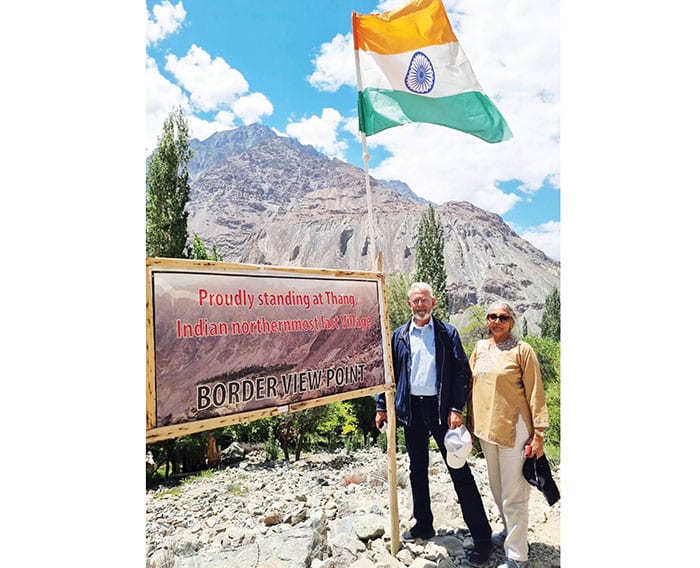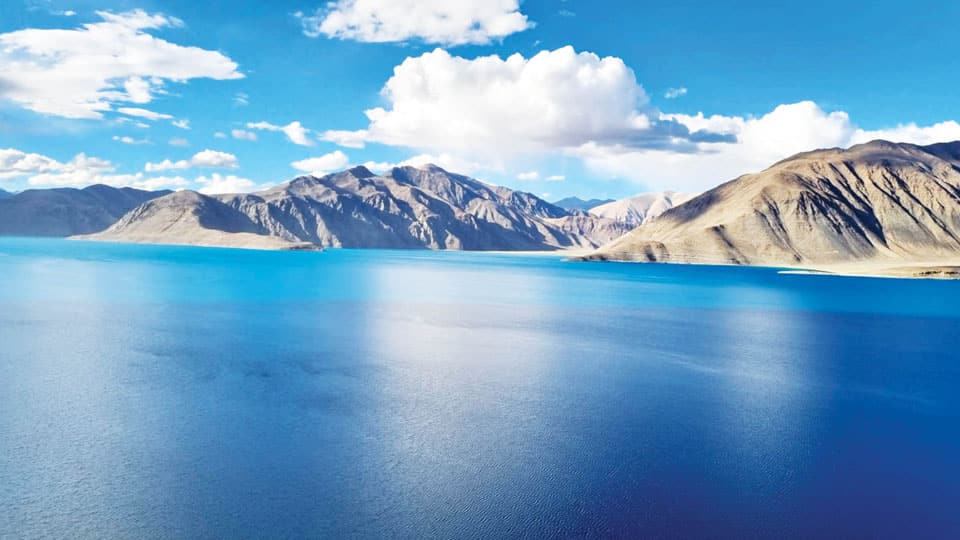By Ashvini Ranjan
[Continued from yesterday]
Takthok Monastery
Let us start our tour with a visit to Takthok Monastery, suggested Namgyal though not on our itinerary. Monasteries are not just temples, volunteered our guide. It is a place of learning about Buddhism, religion, culture and meditation. Takthok Monastery is at a distance of 55 kms from Leh city. Monks in colourful costumes and masks dance to the beat of the drums, flute and the long wind instruments called the Dungchen. The dances are performed as offerings to the monastery deity as well as to signify the victory of good over evil. The masked Cham dances are performed by the monks and the rituals are carried out for a full two days. It reminded me of our own yakshagana folk dances of the coastal districts in Karnataka. In place of masks, yakshagana dancers wear heavy headgears and faces painted in bright colours. And loud too compared to the dances of Ladakh which are slow and gentle in their movements.
Presence of the Armed Forces
One thing that a visitor will not miss is noticing the presence of the military personnel. Ladakh being the bordering State with not so friendly Pakistan and China, presence of the armed forces appeared inevitable for security reasons. Not to forget the bloody battle at Kargil heights not far from Leh. Though two decades had passed since the conflict, the heroic deeds of our soldiers and the ultimate victory gets embedded in every Indian’s mind. ‘At least one member of a Ladakhi family joins the army sir’, said our guide. He then narrated the story of Col. Chewang Rinchen, a recipient of two Maha Vir Chakra (MVC) awards by the Indian army.
Shanti Stupa
It is a few minutes drive from Leh city. It is a pagoda 28 metres high, built with white marble and has a golden pinnacle. It overlooks Leh city and the Valley beyond. The Shanti Stupa was built to promote world peace and prosperity and to commemorate 2,500 years of Buddhism. It is an important place of pilgrimage for Buddhists. The Shanti Stupa holds the relics of the Buddha at its base, it is said.
Pashmina Wool
The small shop at our hotel had done a good job at displaying various Kashmiri fabric and dresses. A woman cannot resist a closer look which then translates into, ‘I want to buy it’. Pashmina wool is native to Ladakh and Kashmir districts. I stopped the purchase last minute by suggesting that we consult about the price and quality with a local person. When I mentioned this to our guide Namgyal, he shared some insights like an expert. He said that Changra goat of Ladakh produces the finest fibre called Pashmina wool. These animals are found at a height of four to five thousand metres above sea level. Each goat roughly produces about two hundred to three hundred grams of wool a year. Hence very expensive. To make it affordable the fabric gets mixed with synthetic material and for a visitor it is difficult to distinguish. Finally the investment was made at a shop that Namgyal suggested. Whether or not the wool was pure, my wife’s happiness seemed genuine !
Leh Palace
Whatever your itinerary be when you travel, it is ultimately dependent on the weather at the time of your visit. A visit to the Leh Palace close to the city was on the cards and the skies opened up to a burst of rain. Let us not waste time for the rain to stop, suggested Namgyal. Let us proceed to Alchi Monastery instead, he said. My readings about Leh classified this Monastery under a must visit category. Leh Palace is enroute to Alchi. From the looks of it from outside, the Leh Palace appeared like an imposing structure but past its glory days. Nine storey high structure and the museum is not in the best of shape sir, volunteered Namgyal. The view of the city from top of the Palace is definitely spectacular, but involves a lot of climbing. The falling rain and the nine flights of stairways seemed to seal our decision to skip the Leh Palace. ‘A month is not enough sir,’ said our guide. At the end of it, there will still be some places left for you to see. So let’s pick the best of places to see as we drove towards Alchi Monastery.

Alchi Monastery
It is on the banks of the Indus River. It is regarded as one of the most important Buddhist centres in Ladakh and known to be a monastic jewel. It dates back to nearly a thousand years. There are five shrines in the Temple Complex with some splendid wall paintings considered among the oldest surviving paintings in Ladakh. One of its walls in the temple complex features thousands of miniature sized pictures of the Buddha, each with a unique message. There are three large sized images of Buddha with elaborate wood carvings. It is no longer an active religious centre. One cannot help but wonder at the strong belief in God and religion of people of those times and the effort that went in creating extraordinary paintings and structures. As we exit the temple complex, the wooded path meanders through souvenir shops, small tea stalls and restaurants. We decided to taste local food at the ‘Alchi Kitchen’ run by a young Ladakhi lady. The Momos and Khambir (bread stuffed with mixed vegetables) made a fine meal. Our next stop was Thiksey village, a two hour drive.
Border Roads
Building roads and bridges at such heights is an astonishing feat. There is a constant movement of rocks due to frequent earthquakes and melting ice. Landslides are common. To carry heavy equipment and construction material to such heights is not an easy task. Construction workers are constantly at risk of injury or loss of life. The extreme weather makes life that much more difficult. Even though vehicle drivers are very skilled, accidents are frequent. Moreso, to army trucks carrying heavy equipment and military personnel.
Pangong Lake and Three Idiots movie
We had packed lunch, courtesy Chamba Camp, for the six hour drive to Pangong Lake, rated one of the biggest tourist attractions of the country. It was made even more famous by the movie ‘Three Idiots’ and the famous scooter ride by the actress Kareena Kapoor on the banks of the lake. To reach there one has to travel on probably the most treacherous part of Ladakhi roads. Many stretches are unpaved, rocky with water streams flowing from the melting ice from the mountains. But the view of the landscape is stunning. Pangong Lake is situated at a height of almost 4,350 metres and is the world’s highest salt water lake. Its water, which seems to be dyed in blue, stands in stark contrast to the arid mountains surrounding it. Extending to almost 160 km, one-third of the Pangong Lake lies in India and the other two-thirds in China. Crystal clear waters, amazing scenic view of the mountains in the backdrop. Surprisingly, the facilities there are very basic. Most accommodation there are tents. The chill of the night could be uncomfortable if not properly prepared. As darkness falls, the stars light up the sky. The sight is truly ethereal.
[To be continued]








Recent Comments